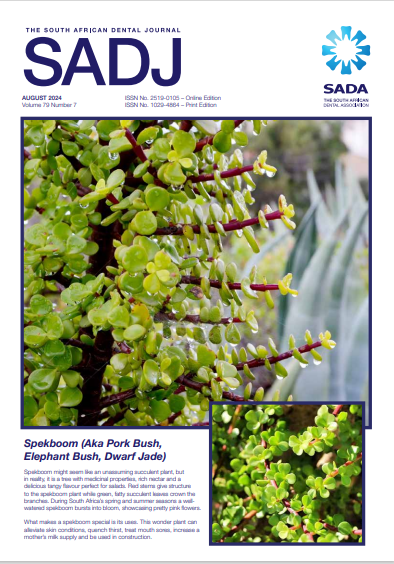Archives
-

The South African Dental Journal
Vol. 80 No. 01 (2025)The Green Point Lighthouse, located in Cape Town, South Africa, is a historic beacon that guides ships along the coast. Built in 1824, it stands at the northern entrance to the Victoria and Alfred Waterfront. With its distinctive white and red stripes, the lighthouse has become an iconic landmark. Originally powered by a coal fire, it now serves as an important maritime navigation aid and a popular tourist destination.
-

The South African Dental Journal
Vol. 79 No. 10 (2024)Common sugarbush (Protea caffra)
A unique plant that is occasionally cultivated in tropical gardens to add texture and color, common sugarbush can either grow as a tree or shrub in its natural South African habitat. In areas where wildfires are common, it has a bush-like growth habit. -

The South African Dental Journal
Vol. 79 No. 08 (2024)The sausage tree (Kigelia africana) is easily recognizable by its large, sausage-shaped fruits that dangle from long stalks. These fruits can grow up to 60 cm in length and are not only visually striking but also highly useful. In traditional African medicine, the fruit is used to treat a variety of ailments, such as skin conditions, digestive issues, and respiratory problems. The wood of the tree is durable and used for crafting, while its flowers attract bats and birds, aiding pollination. However, the fruit is not typically
consumed raw due to its toxicity, requiring special preparation for safe use. -

The South African Dental Journal
Vol. 79 No. 09 (2024)Knob thorn
(Acacia nigrescens)
The knob thorn tree is characterised by the shape of its leaves. Each leaf comprises of four to six leaflets, is rather large with lopsided bases and double pinnately compound. The rachis bends backwards and has small spines. This tree is deciduous, losing its leaves in winter and early spring. New leaves can be bright red in colour. In some cases, individual species of knob thorn trees do not grow knobs on their branches or trunks. It ranges from 5 m to 18 m in height and is fire-resistant. The common name for the knob thorn tree in Afrikaans and English refers to its typically knobbed thorns. -

The South African Dental Journal
Vol. 79 No. 07 (2024)Spekboom might seem like an unassuming succulent plant, but in reality, it is a tree with medicinal properties, rich nectar and a delicious tangy flavour perfect for salads. Red stems give structure
to the spekboom plant while green, fatty succulent leaves crown the branches. During South Africa’s spring and summer seasons a well watered spekboom bursts into bloom, showcasing pretty pink flowers.
What makes a spekboom special is its uses. This wonder plant can alleviate skin conditions, quench thirst, treat mouth sores, increase a mother’s milk supply and be used in construction. -

The South African Dental Journal
Vol. 79 No. 06 (2024)The fever tree, with its smooth lime green trunk, has an almost alien appearance. In spring, bright yellow flower clusters cover its canopy, concealing its thorns. These thorns are used by insect-eating birds to
skewer their prey. The tree’s name comes from the belief that it caused fevers, as it grows in swampy areas where malaria-carrying mosquitoes thrive. Despite this, animals still lounge near the tree and feed on its seedpods and leaves. Interestingly, the bark of the fever tree can be used to relieve fever and eye problems. -

The South African Dental Journal
Vol. 79 No. 05 (2024)The yellowwood tree can grow to more than 30m tall. The towering canopy provides a vibrant feeding ground for birds and insects. Real yellowwoods are a Protected Species and also South Africa’s
national tree. One of the biggest trees in South Africa largest specimens is in the Tsitsikamma forest and stands over 36m tall. This South African tree is over 600 years old and had many of its like before tree felling became popular. -

The South African Dental Journal
Vol. 79 No. 04 (2024)The quiver tree is the largest known aloe species. It is unusual in its class as it can reach heights of up to 7m, very unlike a typical succulent. There are three subspecies of the quiver tree, the largest, the giant quiver tree (Aloe pillansii) is critically endangered. Seeing one of these relics equals witnessing a piece of history as they can live for up to 380 years. The Namib people used dried bark as a base for their arrows. Boiled roots can treat asthma and crushed leaves can ease discomfort from skin disorders or burns.
-

The South African Dental Journal
Vol. 79 No. 03 (2024)Butterfly-shaped leaves make the deciduous mopane seem magical come autumn. After winter the bare branches fill up with small green flowers and new leaves. The Shona people were first to spot that the oblong-shaped leaves resemble butterfly wings, hence the Shona word for butterfly, mopane. The proudly South African tree can be a stout shrub (aka the mopane scrub) or a 25m-tall tree, depending on the soil and weather conditions. Elephants love mopane leaves, but their avid grazing often causes stunted growth. Mopane moths populate the butterfly tree. These insects, when in caterpillar form, are a nutritious food source in African communities.
-

The South African Dental Journal
Vol. 78 No. 09 (2023)Reaching out into both South Africa and neighboring Botswana, the Kgalagadi Transfrontier Park (meaning ‘Great Thirst’) is a desert wilderness with terrain that’stotally unique. Amidst the salt pans, bushveld, and rust-red dunes of the Kalahari are hordes of plains game, such as wildebeest, springbok (South Africa’s national animal), and gemsbok (its original namesake) that are hunted in turn by predators like lions, cheetah, and leopards. Surrounded by nothing but barren wilderness, the game
viewing here is simply astounding. -

The South African Dental Journal
Vol. 78 No. 08 (2023)The Sabie waterfalls route of Mpumalanga
The Sabie Waterfalls Route in Mpumalanga is one of South Africa’s best-kept secrets. This is because visitors are often so captivated by the Blyde River Canyon Nature Reserve, with its magnificent cliffs and stunning views not to mention dazzling flora and fauna. This superb cluster of waterfalls, is often overlooked but it’s all mostly on the way -

The South African Dental Journal
Vol. 78 No. 04 (2023)The peaks of the Drakensberg
Known as the barrier of spears, the sweeping peaks of the Drakensberg stretch over 1 000 km, forming the boundary between South Africa and the kingdom of Lesotho. The beauty of the basalt buttresses and sweeping vistas is enough to make you weep. -

The South African Dental Journal
Vol. 78 No. 03 (2023)Bourke’s Luck potholes of the Blyde River Canyon
These bizarre natural water features, hewn by centuries of water, mark the start of the Blyde River Canyon. Take the 700 metre walk to view these unusual water features. -

The South African Dental Journal
Vol. 78 No. 02 (2023)The baobabs of Mapungubwe
In the far nothern reaches of South Africa lie the remains of the Kingdom of Mapungubwe, a civilisation that existed in Africa in the 13th century, in amongst the sandstone cliffs, riverine forests and the ubiquitous baobab tree, many of them over 1 000 years old, with their root-like branches and wide girth that dominate this land shrouded in legend. -

The South African Dental Journal
Vol. 78 No. 01 (2023)Khi Solar One (KSO), in Upington in the Northern Cape, is Africa’s first concentrated solar power thermal power plant. The solar plant is 140 hectares and produces 50 MW of energy through its Molten Salt Thermal Energy Storage System, reducing the country’s carbon dioxide emissions by about 138 000
metric tons per year. Developed by Spanish company Abengoa and financed by Industrial Development Corporation (IDC) and community group, Khi Community Trust, it is the first tower plant to achieve 24 hours of operation with solar energy only and is part of the Department of Energy’s project to bring a combination of wind and solar energy to generate 17 800 MW from renewable energy by 2030.
Commissioned in 2016, the thermal energy storage project uses molten salt as its storage technology. The power station includes a facility to store steam, enabling it to generate electricity for two hours when the sun is not shining, and uses dry cooling, which dramatically reduces water consumption by two thirds. -

The South African Dental Journal
Vol. 77 No. 10 (2022)Move over Eskom, perhaps it’s time for South Africa to engage with Iceland to solve our looming
chilly and gloomy prospects. Iceland is digging holes into volcanos in search of a new form of
renewable energy. Scientists have begun boring into the world’s deepest geothermal hole (3.1
miles deep) in the Reykjanes peninsula where they hope to use the extreme pressure and heat
to tap into a source of electricity. At these depths, there is a mixture of molten rock and water
which are under extreme heat and pressure. This condition imparts to the water properties that
make it neither a steam or a gas, and turn it into what is known as a “supercritical steam,”.
Supercritical steam has far more potential energy than either of the aforementioned states of
matter, and may be the key to generating vast amounts of electricity. However, even if such
volcanic holes were available in South Africa, we would still need to be ethically conscious
of the negative environmental impact and costs of deep drilling, and weigh these up against
the possible benefits. Ultimately future research needs to focus on renewable and sustainable
energy (and then on dispelling the notion that dentistry is painful and stressful for clinicians and
patients alike!) -

The South African Dental Journal
Vol. 77 No. 09 (2022)Every Spring marks the shift from Winter dormancy to a period of reawakening and transition. The warm temperatures promote the sap to begin coursing through the veins of young saplings, and trigger a sequence of new life and growth. Let’s all take a leaf from nature’s book and use this time for a personal renewal of energy and vitality, and use it to promote self-growth in the year ahead.
-

The South African Dental Journal
Vol. 77 No. 08 (2022)As the mighty Zambezi River with a width of 1,708m crashes over a basalt rock ledge and drops 108 metres down into a powerful whirlpool, it forms the largest sheet of falling water on the planet. Also known as Mosi-oa-Tunya “The Smoke That Thunders” by locals. It provides habitat for several unique species of plants and animals. It is located on the border between Zambia and Zimbabwe and is one of the world’s largest waterfalls, the falling water’s impressive roar can sometimes be heard from 40 kilometres away. On a wind-free day during high-water season, which runs from about February to July depending on the rain, a dazzling cloud of mist can float high above the Falls. This is truly a magnificent wonder of nature. Scottish missionary David Livingstone identified the falls in 1855, providing the English colonial name of Victoria Falls after Queen Victoria.
-

The South African Dental Journal
Vol. 77 No. 07 (2022)Fountain of Life
Visitors to fountains throughout the world have traditionally thrown a few coins into the waters
and made a wish. If granted, it would benefit them personally. A noble twist to this concept is
the fountain at Irene Dairy Farm in Pretoria. The wishing-coins are collected at the end of every
day and donated to the Tshwane SPCA. This is a lovely way of “Making your Dreams Matter”
and “Paying it forwards” at the same time. Visit Irene Farm - and we hope all your wishes come
true!










.png)